Business
Kenyan baobab trees uprooted for export to Georgia; critics call it ‘biopiracy’
Published
11 months agoon
By
admin- Georgia’s former Prime Minister Bidzina Ivanishvili has built a dendrological park that is home to numerous species of giant trees from around the world, as well as exotic birds; now, several living baobab trees in Kenya’s Kilifi region have been uprooted and prepared for export to the park in Georgia.
- The plan to export baobab trees has sparked a public outcry in Kenya and accusations of biopiracy; some baobab species endemic to Madagascar are already endangered or critically endangered, and research shows that the type of baobabs that grow in Kenya face significant threats from climate change.
- Local farmers in Kilifi reportedly were offered cash payments for the trees, which can help them meet their daily needs; while baobab fruits can be sold for use in snacks and other foods, the returns aren’t as much as the farmers could earn by signing a contract to have the trees uprooted and moved.
KILIFI, Kenya — Between 2019 and 2022, during the construction of Kenya’s first-ever expressway in the capital, Nairobi, thousands of trees were felled to pave way for the construction. However, one 100-year-old fig tree “refused” to give in to the pressure of development. Standing right in the way of the intended expressway, the tree was set to be uprooted and transplanted elsewhere. Environmental activists objected to this and fought for the survival of the towering fig tree, known locally as mugumo. Eventually, then-president Uhuru Kenyatta issued a decree to spare the tree, which is held sacred among the Agikuyu community.
Now, around 540 kilometers (336 miles) away in Kilifi, in the coastal part of Kenya, centuries-old gigantic baobab trees, equally revered by sections of the Mijikenda community, face a similar plight. Only this time, the trees’ intended destination is thousands of miles away: the Shekvetili Dendrological Park in the country of Georgia. And this time, it’s not infrastructural development leading to the move, but what could be a billionaire’s whimsical hobby of collecting centuries-old gigantic trees.
An Oct. 24 article by The Guardian reported that farmers in Kilifi were having mature baobab trees uprooted from their farms and selling them for export to Georgia, a country in the Caucasus region situated between the Black Sea and the Caspian Sea. These reports were followed by posts online, including from ecologist and National Geographic explorer Paula Kahumbu, about the incident, sparking a public outcry. According to the article, George Gvasalia, a Georgian national, was responsible for the uprooting of the trees in different regions of Kilifi. This caught the attention of the Kenyan government, with President William Ruto calling for investigations to ascertain that the uprooting of the trees did not violate the Convention on Biodiversity (CBD) and the Nagoya Protocol.
 Tree uprooted elsewhere in Georgia being transported to Shekvetili Dendrological Park. Image courtesy of Batumeli.The Convention on Biological Diversity is an international legal instrument designed to protect biodiversity and ecosystems through its pillars of conservation, sustainable use, and equitable sharing of benefits arising from genetic resources. It is a legally binding treaty ratified by 196 countries, including Kenya and Georgia. The Nagoya Protocol, on the other hand, is an agreement adopted in 2010 based on the CBD. It enshrines frameworks for equitable sharing of benefits arising from utilization of genetic resources.
Tree uprooted elsewhere in Georgia being transported to Shekvetili Dendrological Park. Image courtesy of Batumeli.The Convention on Biological Diversity is an international legal instrument designed to protect biodiversity and ecosystems through its pillars of conservation, sustainable use, and equitable sharing of benefits arising from genetic resources. It is a legally binding treaty ratified by 196 countries, including Kenya and Georgia. The Nagoya Protocol, on the other hand, is an agreement adopted in 2010 based on the CBD. It enshrines frameworks for equitable sharing of benefits arising from utilization of genetic resources.
Environment activists in Kilifi say they believe that the exportation of baobab trees from Kenya is in breach of these agreements. Weeks after President Ruto ordered a probe into the matter, the Ministry of Environment, through a directive to the Kenya Forest Service (KFS), reissued the license to export the trees stating that the trees were neither endangered nor protected and that all legal procedures had been followed.
Although the Kenyan government through KFS allowed for the exportation of the baobab trees noting that they are not endangered, research published in the journal Trees, Forests and People highlights that African baobab trees face significant climatic threats. Two species of baobab, Adansonia grandidieri and A. suarezensis
Gvasalia, who, according to BBC World News, describes himself as an “ardent environmentalist,” is at the receiving end of accusations of exploitation and biopiracy. Biopiracy is the unauthorized acquisition and utilization of biological resources by one party without fair compensation to the communities from where these resources were obtained. Local media reports in Kenya quoted him saying that he was only saving the trees since the locals were “killing the trees” by cutting them down for cultivation. As of publication, at least six of the uprooted trees were being stored at a yard near Bofa Beach and, according to press releases from the transportation company, were scheduled to be transported to Georgia by the end of June.
Mongabay reached out to Gvasalia via LinkedIn and this was his reply to our request for comments, before changing his account profile to private: “First of all you need to drive from Malindi airport [on the southeast Kenya coast] to Kilifi town and count recently destroyed/killed baobab trees by the Malindi highway. Only after that [can you] ask me questions regarding trees.”
 Another Georgian tree being transported by sea to Shekvetili. It’s not infrastructural development leading to this, but what could be a billionaire’s whimsical hobby of collecting centuries-old gigantic trees. Image courtesy of Salome Jashi.Others question the “saving the trees” idea. “The point is that you are taking a whole mature tree and ripping it out of the ground and then transporting it halfway across the world to replant it; I don’t see that there can be any conservation justification for doing that,” says Gus Le Breton, the board chairperson of the African Baobab Alliance, an association of companies and nonprofits that promotes the development of a sustainable baobab products industry in Africa.
Another Georgian tree being transported by sea to Shekvetili. It’s not infrastructural development leading to this, but what could be a billionaire’s whimsical hobby of collecting centuries-old gigantic trees. Image courtesy of Salome Jashi.Others question the “saving the trees” idea. “The point is that you are taking a whole mature tree and ripping it out of the ground and then transporting it halfway across the world to replant it; I don’t see that there can be any conservation justification for doing that,” says Gus Le Breton, the board chairperson of the African Baobab Alliance, an association of companies and nonprofits that promotes the development of a sustainable baobab products industry in Africa.
According to Ina Mohammed, the secretary of Kilifi Climate Change and Governance Platform, an environmental group, the locals who entered into the agreement to sell baobab trees from their properties were exploited. Multiple sources Mongabay spoke to for this article said the locals were offered between 100,000 and 300,000 Kenyan shillings (between $719 and $2,158) for each tree.
“They are supposed to be paying more for each baobab tree, but then people are being given 100,000 [Kenyan shillings] so they don’t want even to find out if it is the right amount or not the right amount; what they know is they just have to sell the baobab trees, and whatever they are going to be offered … they’ll just accept it,” Ina says.
Ina, who is also a volunteer with Voluntary Service Overseas (VSO), a global development charity, says she believes that the community was not made aware of the intended exportation and use of the uprooted baobab trees. She says that the exporters approached vulnerable property owners who had dire need of the money offered.
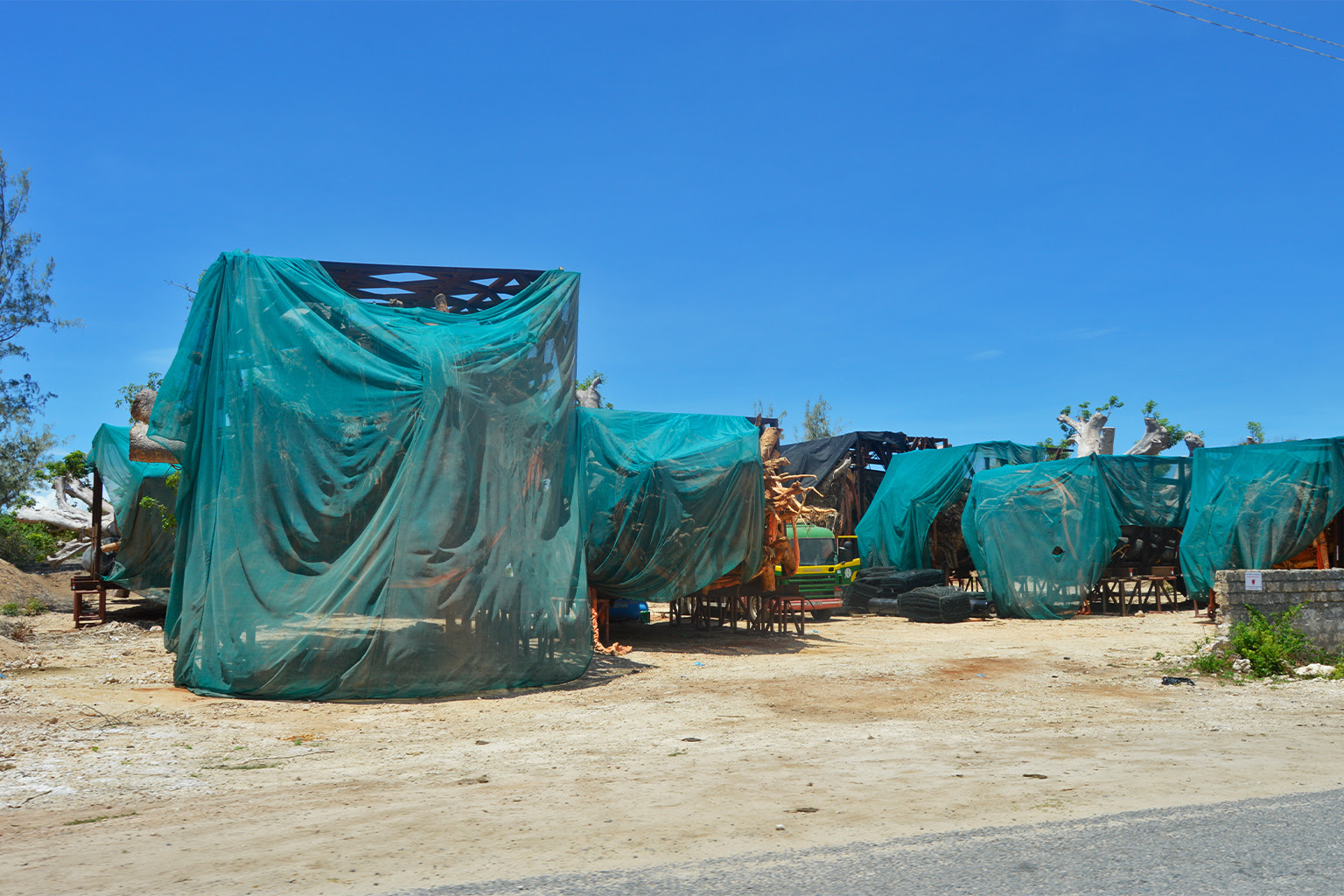 Uprooted trees in Kenya ready for transport. Farmers in Kilifi are having mature baobab trees uprooted from their farms and selling them for export to Georgia. Image by Calvin Rock Odhiambo/Mongabay.
Uprooted trees in Kenya ready for transport. Farmers in Kilifi are having mature baobab trees uprooted from their farms and selling them for export to Georgia. Image by Calvin Rock Odhiambo/Mongabay.
Fast cash to cover daily needs
Some of the locals who entered into contracts to sell their trees, however, said in interviews with local media that they were grateful to Gvasalia for relieving them of the trees, which they did not have much use for, in exchange for cash in addition to the construction of five classrooms and a perimeter wall in a local primary school.
Our attempts to reach out to the sellers were futile, as our fixer stopped answering calls. However, John Otieno, an environmental science undergraduate student at Pwani University in Kilifi, says that having interacted with a farmer who sold three trees from their farm, he understands the farmer’s position. Otieno, together with his colleagues at the Pwani University Environment Club, visited the farmer to get insights on why they had opted to sell their trees.
“He [the property owner] told us that in his farm, there are more than 20 baobabs … and the only benefit he gets from [the trees] is when the seeds are processed into mabuyu,” snacks made from baobab seeds, Otieno says. “Aside from that, there is no other benefit they get from baobabs.”
According to Otieno, in the farmer’s view, the trees also made it hard to cultivate crops since they take up a lot of water from the soil. “He told us, ‘If I was to sell this land, the value of this land will not get to 1 million shillings [$7,196], but here, just with three baobabs, I’m getting almost 1 million without selling the land; yet there are more baobabs in this land,’” Otieno says. “And you could see, they [the farmers] are very poor people, and this was like a silver lining to them — it was like a gold mine in the middle of nowhere for them.”
Otieno says the community was well compensated since besides the money paid to the owners of the trees, the buyers built a school, paved a murram road where there had been none and planted trees to replace the baobabs taken away. He says that while it may not be proper to allow exportation of biodiversity, it is important to consider the resultant benefits to the owners and the community.
According to Otieno, while baobab trees have some economic benefit, the offer of fast cash addressed locals’ immediate needs, such as school fees and food, more so than the intermittent returns from selling baobab fruits would have. Baobab fruits, known locally as ubuyu, have been touted as a superfood, rich in Vitamin C and antioxidants. The pulp is usually dried and ground into powder, which is used in smoothies and porridge as well as in beauty products.
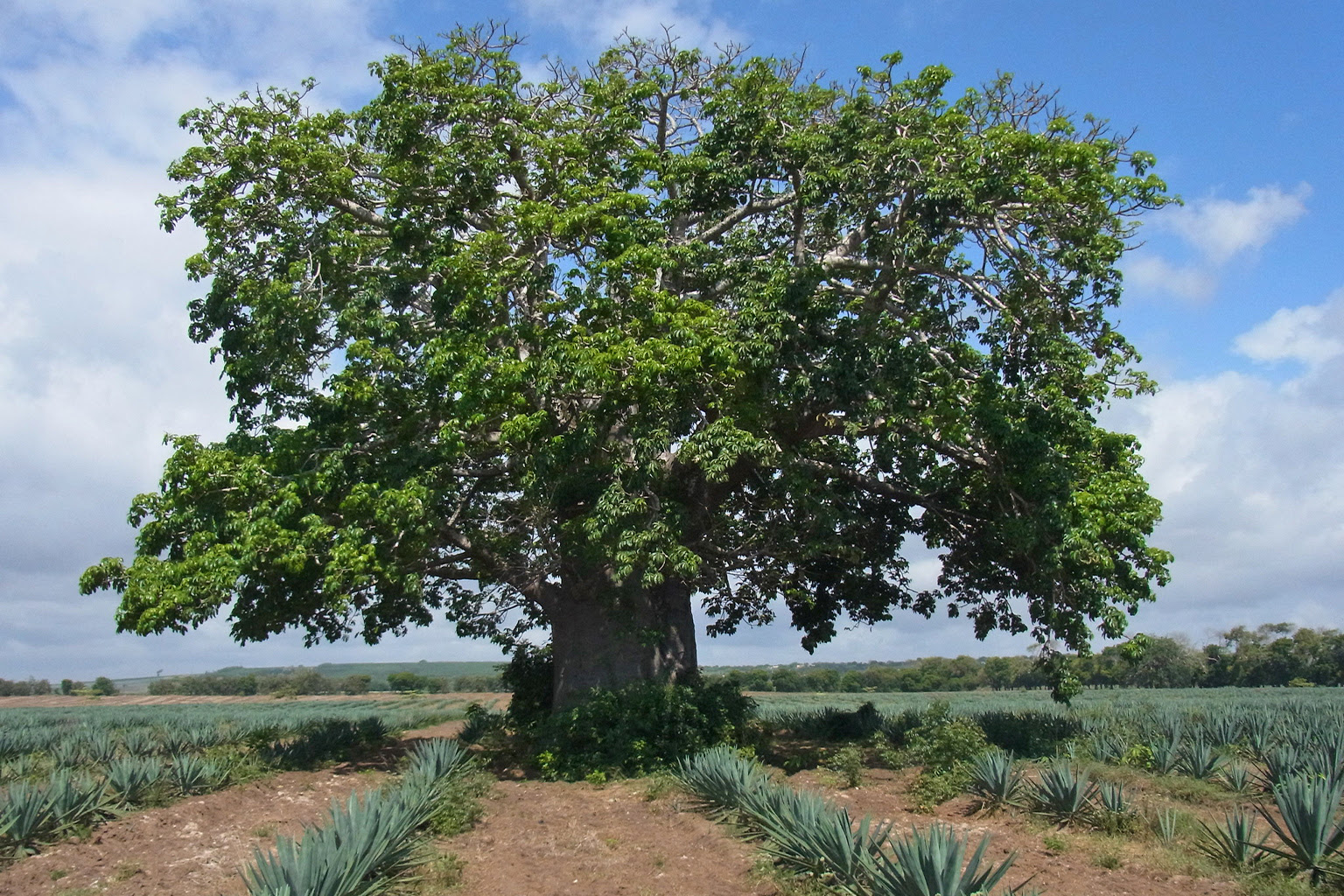 A baobab in a sisal plantation in Kenya. Farmers say the trees make it hard to cultivate crops since they take up a lot of water from the soil. Image by Katja Kehlenbeck/ICRAF via Flickr (CC BY-NC-SA 2.0).Mohamed Almas is a community development expert and the youth senator for Kilifi County in the Youth Senate, an NGO that champions youth participation in political and governance processes. He says that Gvasalia’s claim of saving the trees is far-fetched.
A baobab in a sisal plantation in Kenya. Farmers say the trees make it hard to cultivate crops since they take up a lot of water from the soil. Image by Katja Kehlenbeck/ICRAF via Flickr (CC BY-NC-SA 2.0).Mohamed Almas is a community development expert and the youth senator for Kilifi County in the Youth Senate, an NGO that champions youth participation in political and governance processes. He says that Gvasalia’s claim of saving the trees is far-fetched.
“There is a lot of deforestation going on in Kilifi … but baobab trees [are] not likely to be used for charcoal — that is one big reason why people cut down trees in Kilifi county. I have witnessed people cutting down the trees because they want space for construction,” Mohamed says. “But witnessing people cutting down baobab trees massively — I am yet to experience that. And again, if that is the case, why would they choose to save the baobab tree and not any other tree? Why not save the mangrove, which produces the best charcoal and is used massively in construction?”
According to Global Forest Watch, Kilifi region had the third-highest tree cover loss over the last two decades. The rate of tree cover loss in Kilifi was noted to be nearly three times the national average. Kilifi has many varieties of trees, including wild kapok (Bombax rhodognaphalon), pod mahogany (Afzelia quanzensis), coconut palm (Cocos nucifera) and African fan palm (Borassus aethiopum) and Zebra wood (Brachystegia spiciformis), among others.
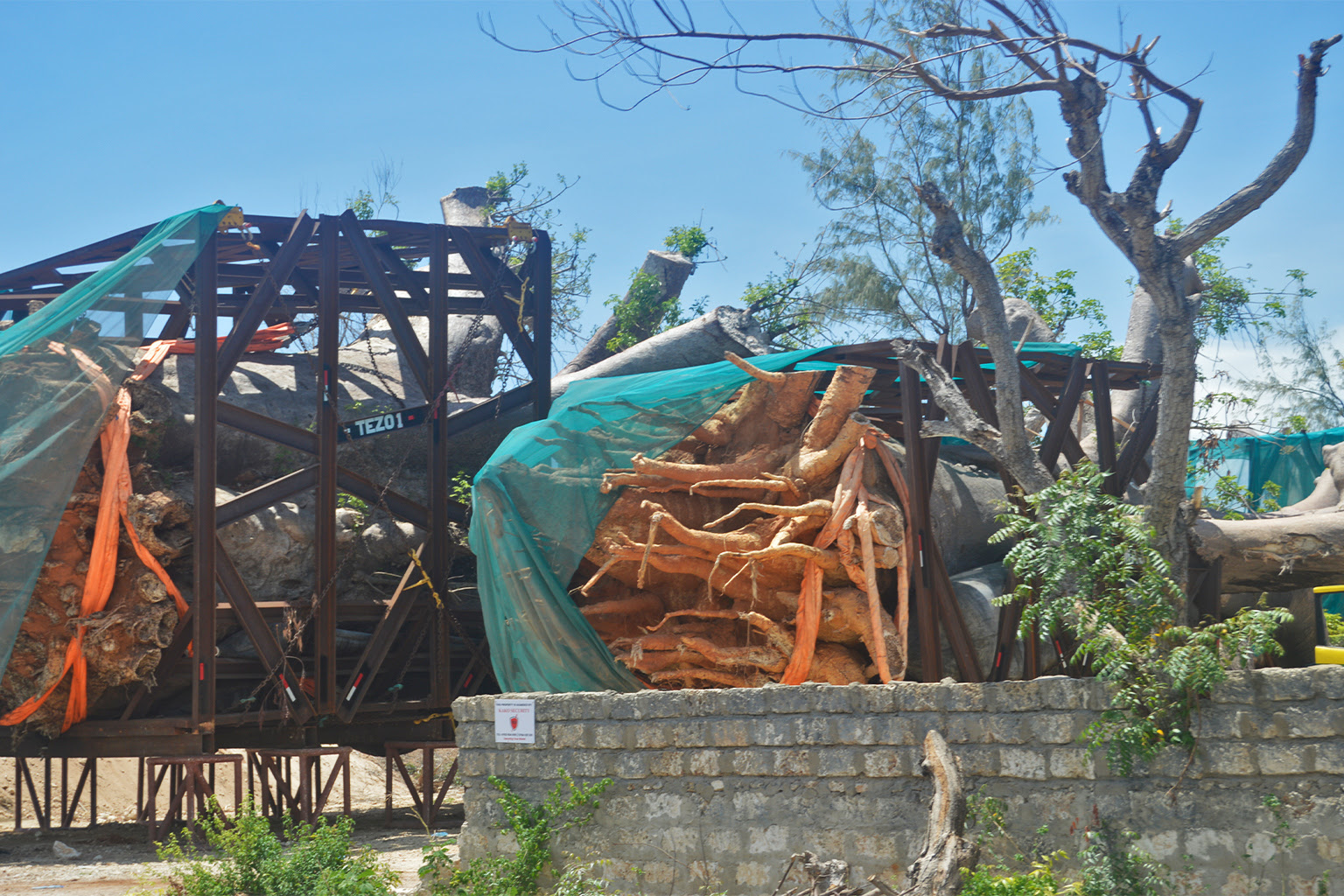 Some of the uprooted trees, stored at a yard near Bofa Beach in Kilifi, are supposed to be transported to Georgia by sea by the end of June. Image by Calvin Rock Odhiambo/Mongabay.
Some of the uprooted trees, stored at a yard near Bofa Beach in Kilifi, are supposed to be transported to Georgia by sea by the end of June. Image by Calvin Rock Odhiambo/Mongabay. According to Global Forest Watch, Kilifi region had the third-highest tree cover loss over the last two decades. Image by Global Forest Watch.
According to Global Forest Watch, Kilifi region had the third-highest tree cover loss over the last two decades. Image by Global Forest Watch.
An ‘addiction’ to giant trees
Although Gvasalia reportedly oversees the uprooting and exportation of the trees here in Kenya, Misha Sesiashvili, a journalist in Georgia who works for Mtavari TV, a media outlet in Georgia that has reported on tree transfers in Georgia, says that Gvasalia is acting on behalf of the billionaire former prime minister of Georgia, Bidzina Ivanishvili. According to Sesiashvili, Ivanishvili has an “addiction” to gigantic trees. The former prime minister, a self-confessed lover of gigantic trees, has in the past been behind similar incidents in Georgia where age-old trees were uprooted and transplanted in the Shekvetili Dendrological Park.
“These trees are transported to Ivanishvili’s dendrological park,” Sesiashvili says, “Ivanishvili lives on the Black Sea coastline in a lavish villa and what is called [the Shekvetili] dendrological park is actually his courtyard. Several years ago, he started uprooting gigantic trees from many different regions of Georgia and planting them in his backyard.”
Shekvetili Dendrological Park is a 60-hectare (148-acre) botanical park that also hosts exotic birds. The park was opened to the public in 2020 and is free to access. Sesiashvili says the trees, transported to the park by sea or land on huge trucks or barges, were moved over distances of up to 70 km (43 mi) from where they were uprooted. He says that despite resigning from government in 2013, and from politics in general in 2021, Ivanishvili still wields significant political influence that enables him to operate with impunity. His clasp on political power is also echoed by a New York Times article headlined, “A Love of Trees or a Display of Power? The Odd Park of an Oligarch.”
A source in Georgia, a journalist who requested anonymity due to the sensitive nature of her work, told Mongabay that Georgian villagers whose trees were uprooted for the park had been expressly told to not speak to journalists or risk termination of the contracts. She added that government funds were used in moving the trees, and in some cases, transnational electricity cables were disconnected to pave the way for transportation of the trees.
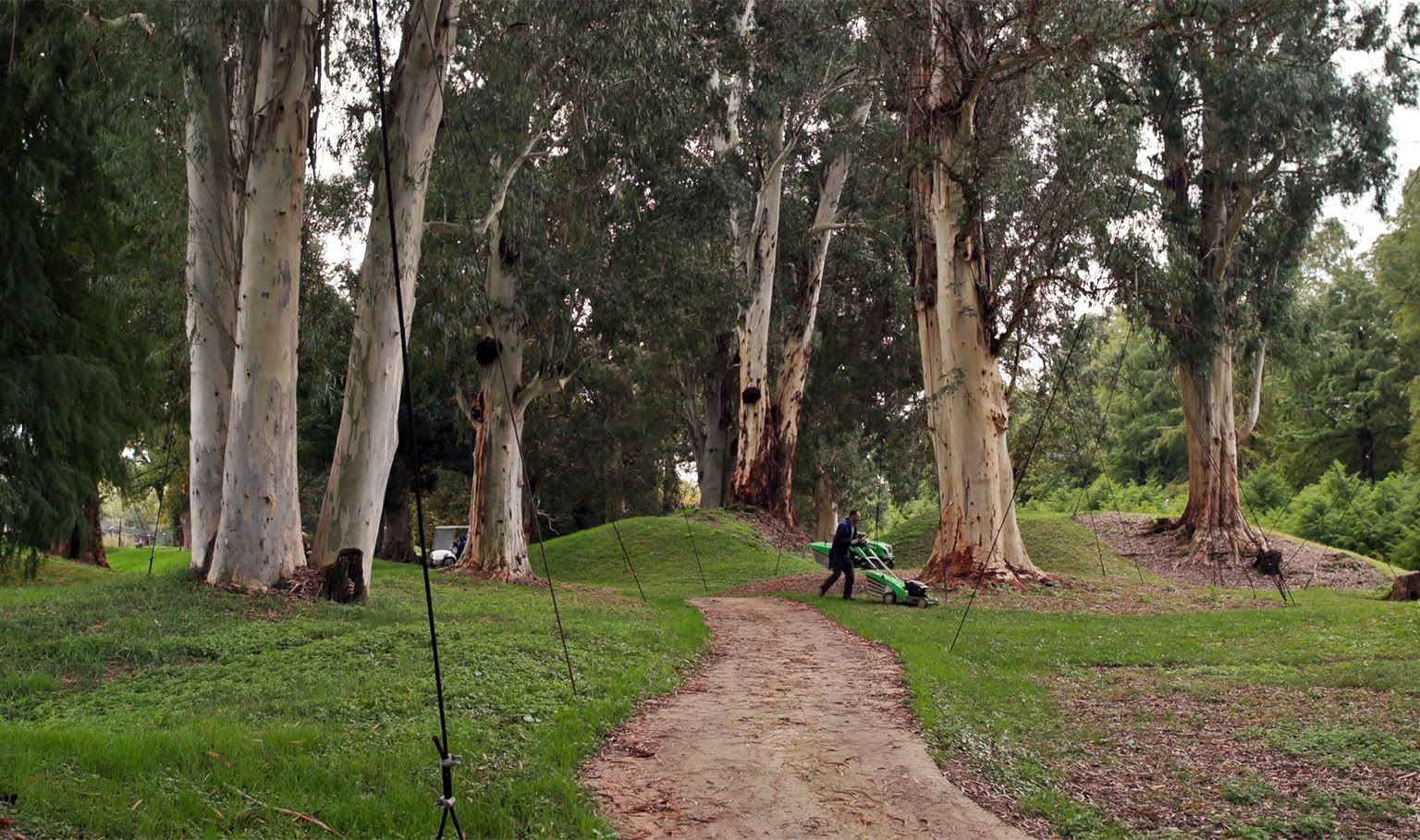 A section of the Shekvetili Dendrological Park, Georgia, where age-old trees from elsewhere have been uprooted and transplanted. Image courtesy of Salome Jashi.
A section of the Shekvetili Dendrological Park, Georgia, where age-old trees from elsewhere have been uprooted and transplanted. Image courtesy of Salome Jashi. In some of the villages in Georgia, trees had to be cut down to pave the roads by which the gigantic trees would be transported. Image courtesy of Salome Jashi.
In some of the villages in Georgia, trees had to be cut down to pave the roads by which the gigantic trees would be transported. Image courtesy of Salome Jashi.
Trees uprooted in Georgia
The dendrological park is also featured in a documentary titled “Taming the Garden” by the award-winning filmmaker Salomé Jashi. It documents the uprooting of trees in Georgian villages and the transfer to Shekvetili.
“When I first saw the image of the tree floating in the sea … where the first tree was taken, for me, it was a beautiful image, mesmerizing; an amazing image, and I felt like, ‘Thank you for showing me this beauty!’” Jashi says. “But on the other hand, it was a very disturbing image and it spoke about power, it spoke about uprooting, migration; it spoke about loneliness, it spoke about masculinity — it had so many dimensions.”
Jashi says a total of 200 trees were moved, and just like in Kenya, there were divided attitudes among locals over the uprooting and transferring of the trees.
“Some [owners] were really happy to get rid of their trees because the big trees would shade their mandarin plantations; but in quite some cases, the locals, either owners or neighbors or villagers, did express their sadness … because this tree was not just an ordinary tree for them, it was the beauty of the village usually; it was often a place where people would sit under, eat something together — which is kind of a communal activity — or drink beer maybe, or just talk or be at the shade or play,” Jashi says.
Similarly, In Kilifi, locals often use baobab trees as meeting points and shelter from the hot temperatures that average 26 degrees Celsius (78.8 degrees Fahrenheit).
Jashi adds that there were complexities attached to the uprooting of the trees since, in return for the emotional trauma caused, the owners received financial compensation, which they needed desperately.
In 2019, Jashi filmed Gvasalia prospecting for baobab trees in Zanzibar to transport to Georgia. The plan later fell through under unclear circumstances. In one piece of Jashi’s footage, Gvasalia can be seen surveying the area using a drone as he engages a local. He then says, “So it [baobab] can survive in Georgia very easily?”
In the 8-minute footage, Jashi also filmed a conversation between Gvasalia and Rashid Ali Juma, Zanzibar’s minister for agriculture, natural resources, livestock and fisheries, in which Gvasalia expressed interest in transferring baobab trees to Georgia.
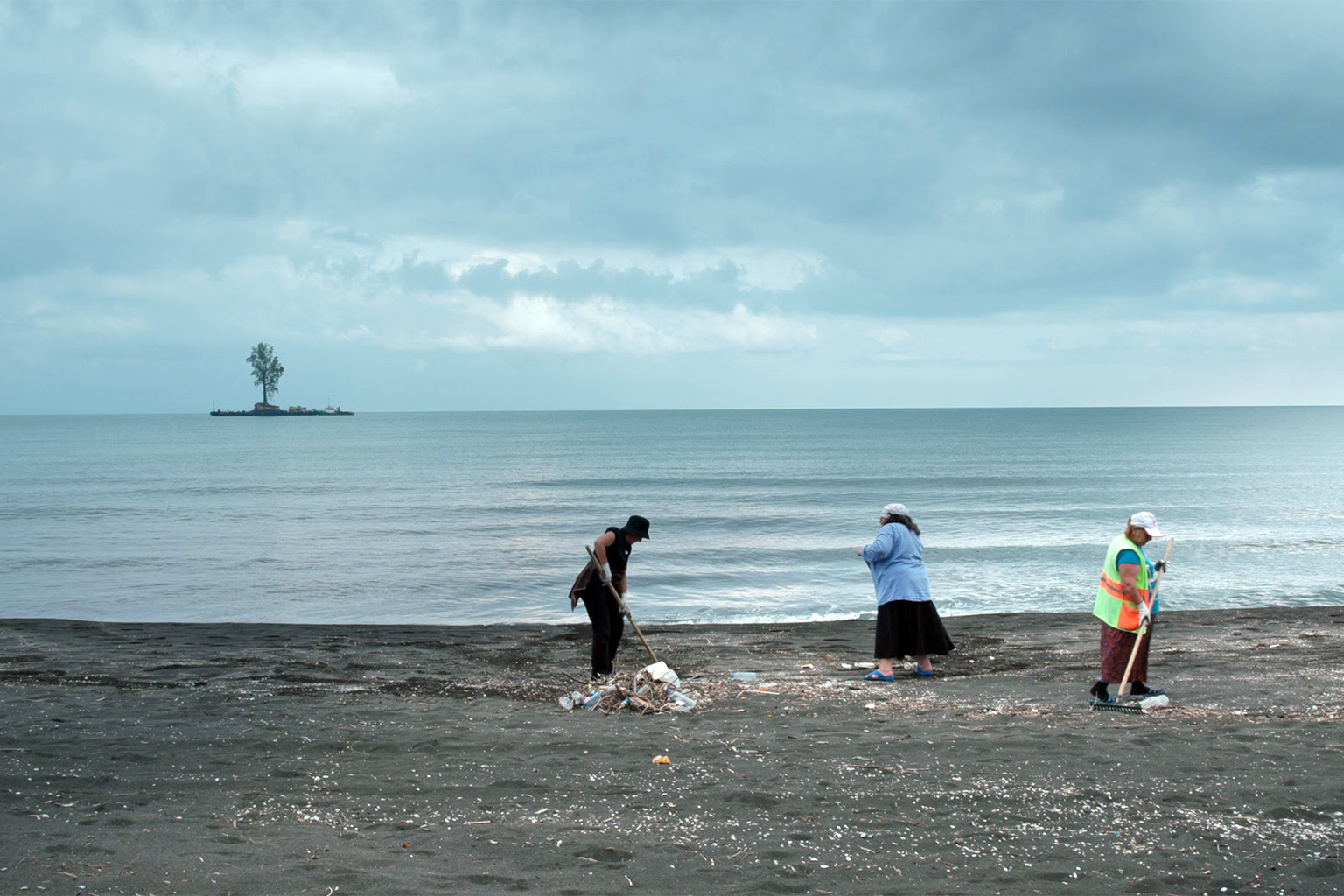 A scene from the documentary “Taming the Garden,” which documents the uprooting of trees in Georgian villages and the transfer to Shekvetili. Image courtesy of Salome Jashi.
A scene from the documentary “Taming the Garden,” which documents the uprooting of trees in Georgian villages and the transfer to Shekvetili. Image courtesy of Salome Jashi. A hole remains in the ground where a tree was uprooted in Georgia. Image courtesy of Salome Jashi.
A hole remains in the ground where a tree was uprooted in Georgia. Image courtesy of Salome Jashi.
Part of Kenya’s biological heritage
Le Breton of the Africa Baobab Alliance says that the expected long-term economic benefit of the trees is nothing compared with a one-off payment. He first got wind of the uprooting in September 2022, when he was contacted by stakeholders, and he in turn contacted a journalist with The Guardian.
“When I was initially contacted, the issue was that this export did not appear to have all the legal boxes ticked,” Le Breton says. “The fact is, this is a tree that has grown up and survived through many different generations of humans, it has seen a lot of history, and fundamentally it is part of Kenya’s biological heritage, and I think it is very sad that the Kenyan government would sanction its uprooting for the sake of a few dollars that would soon be spent.”
A section of the Mijikenda community, which inhabits the coastal parts of Kenya, consider the baobab trees sacred and a vital part of their cultural heritage. The trees were used in the past by Mijikenda elders as shrines and places where traditional and spiritual oaths were administered. Some of the community members also believe that evil spirits inhabit the trunks of the trees.
Le Breton acknowledges that while the legal requirements for the exportation of the trees may have been met, he says it is not right to transfer the centuries-old trees because of the cultural significance to the community.
In a statement, following the president’s directive for the matter to be investigated, Soipan Tuya, Kenya’s cabinet secretary for environment, climate change and forestry, said, “The uprooting of the baobab trees needed adequate authorization and a clear and transparent benefit sharing formula for the community.” She said these had not been obtained in this case, further noting that the trees are a natural heritage protected by the Constitution. It is not clear what changed with regards to these sentiments, allowing for the exportation. (As of publication, the Ministry of Environment, Climate Change and Forestry as well as the National Environment Management Authority have not responded to Mongabay’s requests for comment.)
 A baobab tree (Adansonia digitata) at the Haller Park in Bamburi, Mombasa. The tree is at least 39 years old. Image by Calvin Rock Odhiambo/Mongabay.“I still believe this is utterly ridiculous because baobabs — the reason they only naturally occur in Sub-Saharan Africa is because they are ecologically adapted to the niche that Sub-Saharan Africa provides. Georgia, which is a subtropical [climate] country and prone to frost and even snow in the winter, is clearly not a suitable climate for baobab,” Le Breton says. “I am pretty confident that what will happen at the end is all these trees that have been uprooted and shipped to Georgia will die.”
A baobab tree (Adansonia digitata) at the Haller Park in Bamburi, Mombasa. The tree is at least 39 years old. Image by Calvin Rock Odhiambo/Mongabay.“I still believe this is utterly ridiculous because baobabs — the reason they only naturally occur in Sub-Saharan Africa is because they are ecologically adapted to the niche that Sub-Saharan Africa provides. Georgia, which is a subtropical [climate] country and prone to frost and even snow in the winter, is clearly not a suitable climate for baobab,” Le Breton says. “I am pretty confident that what will happen at the end is all these trees that have been uprooted and shipped to Georgia will die.”
In Georgia, Sesiashvili says, between 30 and 40 trees have been uprooted across the country but not all survived. In Kenya, according to KFS, the license issued to Gvasalia was for eight trees, although some locals in Kilifi claim that even more have been uprooted. Seshiashvili says he believes the reason for exporting eight trees is so that in case some die, others would survive.
Mongabay contacted the National Botanic Gardens of Glasnevin, in Dublin, Ireland, where an African baobab tree is grown in a glasshouse under controlled conditions. “Our baobab will never be able to achieve anything like the stature it would in its native habitat … but as a specimen in our collections, it hopefully helps our visitors connect with plant diversity and the need for its protection in all the countries of the world,” Ita Patton, the foreperson of the glasshouse, says in an email. “Our success with cultivating this disparate collection [varieties of plants from different continents are grown in the garden] is due to the knowledgeable and attentive staff that can manipulate the application of water, ventilation and nutrition to counteract any adverse reactions to lower temperatures.”
According to Le Breton, there is possible justification to take genetic material from one part of the world to another for conservation purposes. However, he asserts that this is only justifiable in the case when an organism is endangered, and even so, it would make sense to conserve the seed for reproduction, not the entire organism.
“We have seed banks … where many seeds of many different plants from around the world are stored, in case the wild plant ever went extinct and we would then have genetic material from which to reproduce it. And I believe there has been an element of that argument employed in this case in Georgia — that this is an endangered tree and it needs to be protected,” Le Breton says. “But that is patently nonsense because first of all, it’s not an endangered tree [species].”
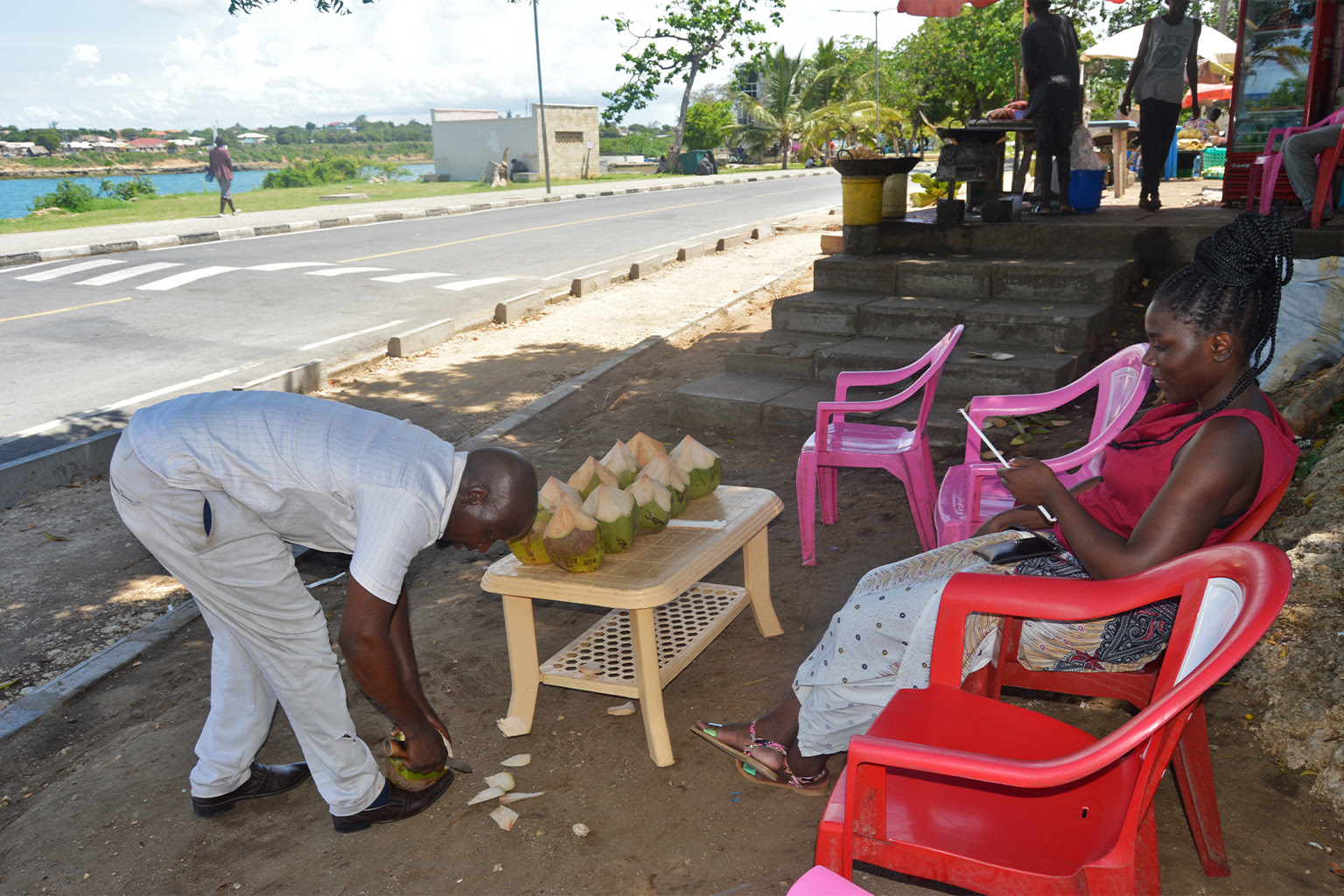 Vendors serve food under the shade of a baobab tree. Image by Calvin Rock Odhiambo/Mongabay.
Vendors serve food under the shade of a baobab tree. Image by Calvin Rock Odhiambo/Mongabay.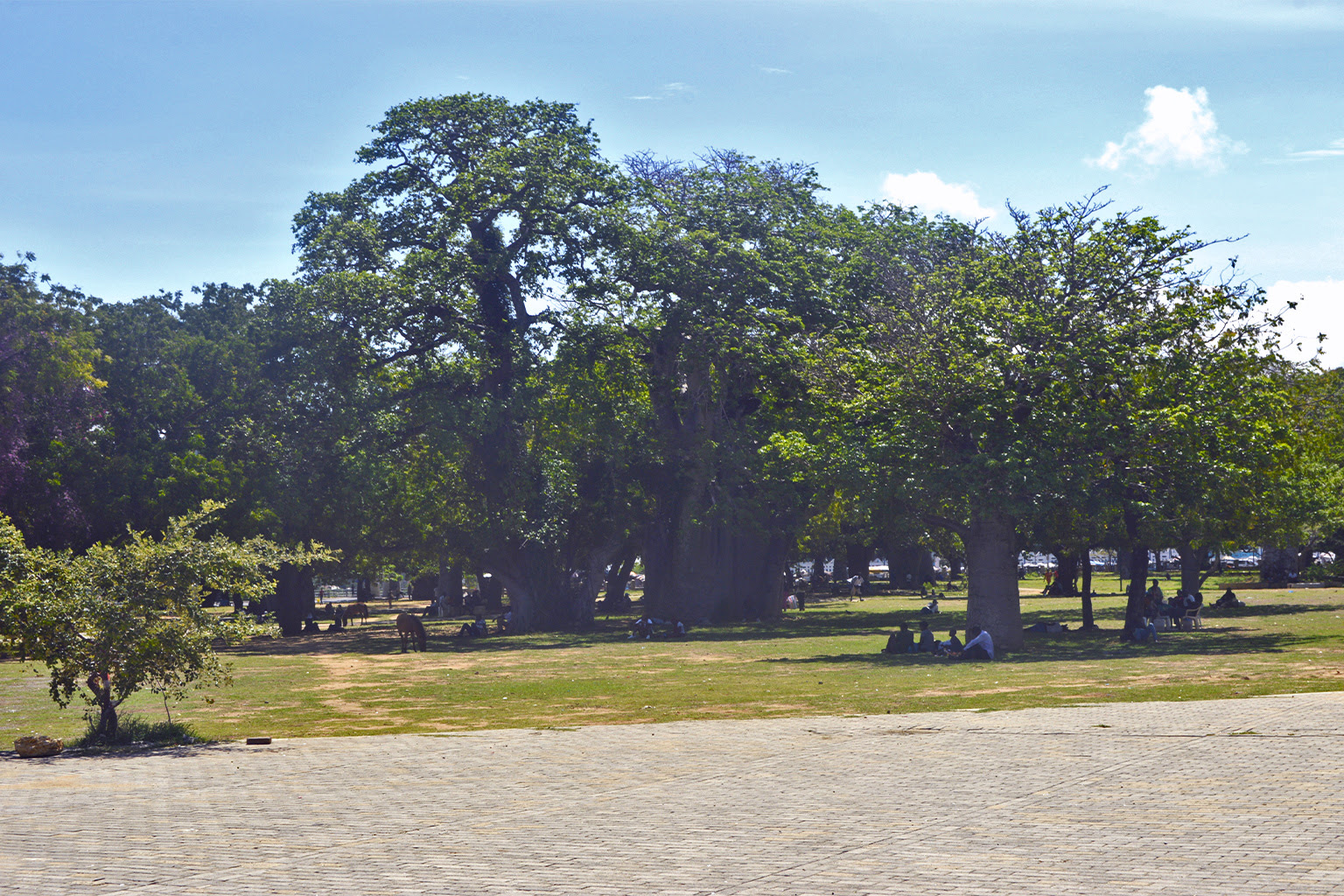 Mama Ngina Waterfront, a recreational park in Mombasa, has dozens of baobab trees that provide shade to visitors. Image by Calvin Rock Odhiambo/Mongabay.Sesiashvili says opinions are divided in Georgia about the importation of baobab trees from Kenya. While some think it is OK since people would not otherwise have a chance to see these trees, others think Ivanishvili’s uprooting gigantic trees and transporting them over thousands of kilometers is a rather extravagant “hobby,” and the money could have been put to better use. Sesiashvili says many Georgians consider it an extraordinary and a megalomaniac thing to do.
Mama Ngina Waterfront, a recreational park in Mombasa, has dozens of baobab trees that provide shade to visitors. Image by Calvin Rock Odhiambo/Mongabay.Sesiashvili says opinions are divided in Georgia about the importation of baobab trees from Kenya. While some think it is OK since people would not otherwise have a chance to see these trees, others think Ivanishvili’s uprooting gigantic trees and transporting them over thousands of kilometers is a rather extravagant “hobby,” and the money could have been put to better use. Sesiashvili says many Georgians consider it an extraordinary and a megalomaniac thing to do.
“Georgia is a poor country; we have a lot of social problems, a lot of poverty, even in villages where he uprooted these trees. So it is kind of unexplainable for these people to see that they live in poverty and somebody can spend 1 million or 2 million laris ($382,000-765,000) just to uproot one tree and plant in his backyard,” Seshiashvili says.
There are still questions needing answers regarding the uprooting and exportation of the baobab trees. With Kenya’s government agencies seemingly silent about the questions raised by activists and journalists, the questions will continue to linger. However, some stakeholders are worried that this may be setting a precedent that will eventually paint Kenya in a bad light. Yet, according to Le Breton, the solution may lie in shaming the parties involved and shaming the government into reconsidering the decision to allow for the “irregular” and probably “unethical” transfer of genetic resources.
Banner image: One of the uprooted trees in Georgia arriving at its new home in the Shekvetili, where the former prime minister has built a dendrological park with trees from around the world. Image courtesy of Salome Jashi.
Citation:
Asogwa, I. S., Ibrahim, A. N., & Agbaka, J. I. (2021). African baobab: Its role in enhancing nutrition, health, and the environment. Trees, Forests and People, 3, 100043. doi:10.1016/j.tfp.2020.100043
Mogabay



















